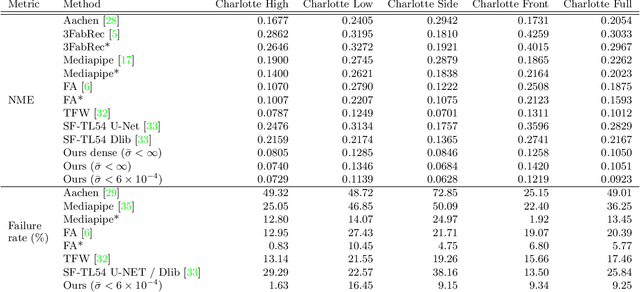Philipp Flotho
Systems Neuroscience & Neurotechnology Unit, Faculty of Medicine, Saarland University & htw saar
T-FAKE: Synthesizing Thermal Images for Facial Landmarking
Aug 27, 2024



Abstract:Facial analysis is a key component in a wide range of applications such as security, autonomous driving, entertainment, and healthcare. Despite the availability of various facial RGB datasets, the thermal modality, which plays a crucial role in life sciences, medicine, and biometrics, has been largely overlooked. To address this gap, we introduce the T-FAKE dataset, a new large-scale synthetic thermal dataset with sparse and dense landmarks. To facilitate the creation of the dataset, we propose a novel RGB2Thermal loss function, which enables the transfer of thermal style to RGB faces. By utilizing the Wasserstein distance between thermal and RGB patches and the statistical analysis of clinical temperature distributions on faces, we ensure that the generated thermal images closely resemble real samples. Using RGB2Thermal style transfer based on our RGB2Thermal loss function, we create the T-FAKE dataset, a large-scale synthetic thermal dataset of faces. Leveraging our novel T-FAKE dataset, probabilistic landmark prediction, and label adaptation networks, we demonstrate significant improvements in landmark detection methods on thermal images across different landmark conventions. Our models show excellent performance with both sparse 70-point landmarks and dense 478-point landmark annotations. Our code and models are available at https://github.com/phflot/tfake.
Lagrangian Motion Magnification with Double Sparse Optical Flow Decomposition
Apr 15, 2022



Abstract:Motion magnification techniques aim at amplifying and hence revealing subtle motion in videos. There are basically two main approaches to reach this goal, namely via Eulerian or Lagrangian techniques. While the first one magnifies motion implicitly by operating directly on image pixels, the Lagrangian approach uses optical flow techniques to extract and amplify pixel trajectories. Microexpressions are fast and spatially small facial expressions that are difficult to detect. In this paper, we propose a novel approach for local Lagrangian motion magnification of facial micromovements. Our contribution is three-fold: first, we fine-tune the recurrent all-pairs field transforms for optical flows (RAFT) deep learning approach for faces by adding ground truth obtained from the variational dense inverse search (DIS) for optical flow algorithm applied to the CASME II video set of faces. This enables us to produce optical flows of facial videos in an efficient and sufficiently accurate way. Second, since facial micromovements are both local in space and time, we propose to approximate the optical flow field by sparse components both in space and time leading to a double sparse decomposition. Third, we use this decomposition to magnify micro-motions in specific areas of the face, where we introduce a new forward warping strategy using a triangular splitting of the image grid and barycentric interpolation of the RGB vectors at the corners of the transformed triangles. We demonstrate the very good performance of our approach by various examples.
 Add to Chrome
Add to Chrome Add to Firefox
Add to Firefox Add to Edge
Add to Edge